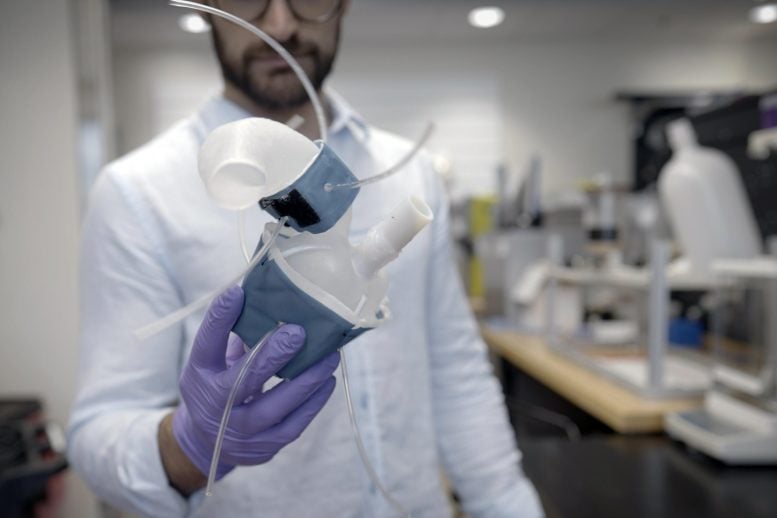
MIT engineers are hoping to assist medical doctors tailor therapies to sufferers’ particular coronary heart shape and serve as, with a customized robot coronary heart. The group has evolved a process to 3-d print a cushy and versatile copy of a affected person’s coronary heart. Credit score: Melanie Gonick, MIT
The cushy robot coronary heart fashions are patient-specific and may assist clinicians 0 in on the most productive implant for a person.
No two hearts beat alike. The dimensions and form of the center can range from one particular person to the following. Those variations may also be in particular pronounced for other folks dwelling with coronary heart illness, as their hearts and main vessels paintings tougher to conquer any compromised serve as.
Massachusetts Institute of Era (MIT) engineers are hoping to assist medical doctors tailor therapies to sufferers’ particular coronary heart shape and serve as, with a customized robot coronary heart. The group has evolved a process to 3-d print a cushy and versatile copy of a affected person’s coronary heart. They are able to then keep an eye on the copy’s motion to imitate that affected person’s blood-pumping talent.
The process comes to first changing clinical pictures of a affected person’s coronary heart right into a three-d pc style, which the researchers can then 3-d print the use of a polymer-based ink. The result’s a cushy, versatile shell within the precise form of the affected person’s personal coronary heart. The group too can use this strategy to print a affected person’s aorta — the key artery that carries blood out of the center to the remainder of the frame.
To imitate the center’s pumping motion, the group has fabricated sleeves very similar to blood drive cuffs that wrap round a broadcast coronary heart and aorta. The bottom of every sleeve resembles exactly patterned bubble wrap. When the sleeve is hooked up to a pneumatic device, researchers can music the outflowing air to rhythmically inflate the sleeve’s bubbles and contract the center, mimicking its pumping motion.
The researchers too can inflate a separate sleeve surrounding a broadcast aorta to constrict the vessel. This constriction, they are saying, may also be tuned to imitate aortic stenosis — a situation during which the aortic valve narrows, inflicting the center to paintings tougher to power blood during the frame.

The motion of the cushy, robot fashions may also be managed to imitate the affected person’s blood-pumping talent. Credit score: Melanie Gonick, MIT
Medical doctors often deal with aortic stenosis by means of surgically implanting a man-made valve designed to widen the aorta’s herbal valve. Someday, the group says that medical doctors may probably use their new process to first print a affected person’s coronary heart and aorta, then implant various valves into the broadcast style to look which design leads to the most productive serve as and have compatibility for that exact affected person. The center replicas may be utilized by analysis labs and the clinical instrument trade as sensible platforms for checking out treatments for quite a lot of varieties of coronary heart illness.
“All hearts are other,” says Luca Rosalia, a graduate scholar within the MIT-Harvard Program in Well being Sciences and Era. “There are huge permutations, particularly when sufferers are ill. The good thing about our device is that we will be able to recreate no longer simply the type of a affected person’s coronary heart, but additionally its serve as in each body structure and illness.”
Rosalia and his colleagues record their leads to a learn about showing lately in Science Robotics. MIT co-authors come with Caglar Ozturk, Debkalpa Goswami, Jean Bonnemain, Sophie Wang, and Ellen Roche, in conjunction with Benjamin Bonner of Massachusetts Common Health facility, James Weaver of Harvard College, and Christopher Nguyen, Rishi Puri, and Samir Kapadia on the Cleveland Health center in Ohio.
Print and pump
In January 2020, group participants, led by means of mechanical engineering professor Ellen Roche, evolved a “biorobotic hybrid coronary heart” — a common copy of a coronary heart, created from artificial muscle containing small, inflatable cylinders, which they might keep an eye on to imitate the contractions of an actual beating coronary heart.
In a while after the ones efforts, the Covid-19 pandemic compelled Roche’s lab, in conjunction with maximum others on campus, to briefly shut. Undeterred, Rosalia persisted tweaking the heart-pumping design at house.
“I recreated the entire device in my dorm room that March,” Rosalia remembers.
Months later, the lab reopened, and the group persisted the place it left off, operating to support the keep an eye on of the heart-pumping sleeve, which they examined in animal and computational fashions. They then expanded their strategy to increase sleeves and coronary heart replicas which are particular to person sufferers. For this, they grew to become to 3-d printing.
“There may be a large number of pastime within the clinical box in the use of 3-d printing era to correctly recreate affected person anatomy to be used in preprocedural making plans and coaching,” notes Wang, who’s a vascular surgical treatment resident at Beth Israel Deaconess Clinical Middle in Boston.
An inclusive design
Within the new learn about, the group took benefit of 3-d printing to supply customized replicas of exact sufferers’ hearts. They used a polymer-based ink that, as soon as revealed and cured, can squeeze and stretch, in a similar fashion to an actual beating coronary heart.
As their supply subject matter, the researchers used clinical scans of 15 sufferers recognized with aortic stenosis. The group transformed every affected person’s pictures right into a three-d pc style of the affected person’s left ventricle (the principle pumping chamber of the center) and aorta. They fed this style right into a 3-d printer to generate a cushy, anatomically correct shell of each the ventricle and vessel.
The group additionally fabricated sleeves to wrap across the revealed paperwork. They adapted every sleeve’s wallet such that, when wrapped round their respective paperwork and hooked up to a small air pumping device, the sleeves might be tuned one by one to realistically contract and constrict the broadcast fashions.
The researchers confirmed that for every style coronary heart, they might correctly recreate the similar heart-pumping pressures and flows that have been in the past measured in every respective affected person.
“With the ability to fit the sufferers’ flows and pressures was once very encouraging,” Roche says. “We’re no longer most effective printing the center’s anatomy, but additionally replicating its mechanics and body structure. That’s the phase that we get enthusiastic about.”
Going a step additional, the group aimed to copy probably the most interventions {that a} handful of the sufferers underwent, to look whether or not the broadcast coronary heart and vessel replied in the similar means. Some sufferers had gained valve implants designed to widen the aorta. Roche and her colleagues implanted an identical valves within the revealed aortas modeled after every affected person. After they activated the broadcast coronary heart to pump, they noticed that the implanted valve produced in a similar fashion advanced flows as in precise sufferers following their surgical implants.
In the end, the group used an actuated revealed coronary heart to match implants of various sizes, to look which might lead to the most productive have compatibility and drift — one thing they envision clinicians may probably do for his or her sufferers at some point.
“Sufferers would get their imaging finished, which they do anyway, and we might use that to make the program, preferably inside the day,” says co-author Nguyen. “As soon as it’s up and operating, clinicians may check other valve sorts and sizes and notice which goes perfect, then use that to implant.”
In the end, Roche says the patient-specific replicas may assist increase and establish ideally suited therapies for people with distinctive and difficult cardiac geometries.
“Designing inclusively for a wide range of anatomies, and checking out interventions throughout this vary, might building up the addressable goal inhabitants for minimally invasive procedures,” Roche says.
Reference: “Cushy robot patient-specific hydrodynamic style of aortic stenosis and ventricular transforming” by means of Luca Rosalia, Caglar Ozturk, Debkalpa Goswami, Jean Bonnemain, Sophie X. Wang, Benjamin Bonner, James C. Weaver, Rishi Puri, Samir Kapadia, Christopher T. Nguyen and Ellen T. Roche, 22 February 2023, Science Robotics.
DOI: 10.1126/scirobotics.ade2184
This analysis was once supported, partially, by means of the Nationwide Science Basis, the Nationwide Institutes of Well being, and the Nationwide Center Lung Blood Institute.
Supply Via https://scitechdaily.com/mits-3d-printed-robotic-hearts-look-and-pump-just-like-the-real-thing/



